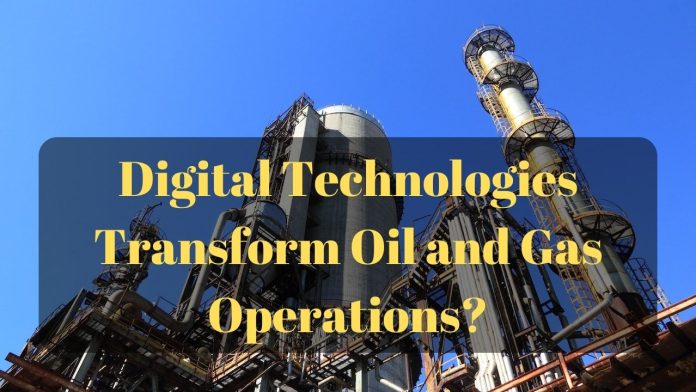Initially, digital technology adoption in the oil and gas sector was patchy, with a focus on a few key pieces of equipment and operations. Previously, digital technology implementation was limited by a lack of readily available, qualified professionals, concerns about data security, and uncertainty about the cost-benefit analysis of replacing aging assets.
To maximize long-term revenues, an increasing number of oil and gas companies are modernizing their assets by using digital technologies. Increased use of artificial intelligence, cloud computing, the internet of things, and robotics is likely to change the industry and create a synchronized ecosystem to meet future energy requirements.
These technologies can provide insights that may be applied to an oil and gas asset, supporting firms in cutting capital and operating costs. The major objective of digitalization will be to decrease the amount of downtime experienced by equipment while boosting operational performance. It is also becoming more vital for oil and gas firms to digitize their processes to boost the visibility of their operations and, as a result, their decision-making capabilities. Adapting previously proven concepts, such as digital twins and predictive maintenance, to a larger range of use cases within the oil and gas value chain is becoming increasingly frequent.
Here are some areas that digital transformation that may help with oil & gas field exploration procedures and the associated processes.
Artificial Intelligence and Data Science
Big data and artificial intelligence have the potential to deliver strong analytics platforms for increased operational and managerial efficiency across the oil and gas supply chain. These platforms can provide a competitive edge to the oil and gas sector. This might make it simpler to avoid disruptions. The use of advanced analytics in combination with cloud applications could reduce infrastructure costs.
The application of current analytics allows for the assessment of seismic data to provide risk insights throughout the process of choosing a location for oil drilling. Thus, the success rate may be enhanced while expenses and time are reduced. Furthermore, seismic data analysis may be used in combination with historical data to calculate the quantity of oil contained in reservoirs.
Large volumes of data generated by expensive equipment operating on offshore drilling platforms might be used for predictive asset maintenance, thereby reducing the number of times equipment fails.
Industrial IoT
Accidents like leaks and other sorts of damage during the extraction process may result in substantial financial and environmental losses. Using real-time data from the Internet of Things (IoT), oil companies can undertake effective monitoring of the system’s pipes, pumps, and filters. This would help to prevent leaks. Thus, unnecessary manual system checks have been removed, and human resources are only deployed in reaction to the identification of anomalies.
When sensors are integrated with the internet of things, it is feasible to have remote access to data on the operation and maintenance of huge machinery used in offshore drilling. Most of the time, these devices are in remote areas, making them vulnerable to harsh weather.
Furthermore, sensors enabled by the Internet of Things may provide real-time data that can be utilized to regulate different performance parameters. As a result, data acquired in real-time could now be accessed around the clock to perform exact measurements.
Oil and gas delivery boats are limited in their ability to visit a variety of sites due to their size. Low-power wide-area networks allow crew members to monitor real-time data while working on the ship and doing repairs.
Automation
The value of the global market for automation technology in the oil and gas sector is expected to almost double by 2030, reaching roughly $42 billion at that time. The closure process in the oil and gas business may be automated by utilizing robotic process automation, resulting in increased audibility, a lower risk of human error, and a considerable reduction in the amount of time necessary to complete a contract.
Procurement transaction automation in the oil and gas supply chain has the potential to drastically reduce cycle times and boost overall efficiency. This is achievable through the use of robotic process automation (RPA).
Automated technologies for studying difficult regions, such as the utilization of drones and underwater robots, are becoming increasingly popular during offshore drilling. When personnel install new components and replace old ones in potentially dangerous places, bots may reduce the number of errors made by humans and make working conditions safer for them.
Augmented Reality and Virtual Reality
The market for augmented reality (AR) and virtual reality (VR) is expected to have grown by a factor of 10 by 2024, reaching a value of more than $300 billion. The adoption of virtual reality headsets allows employees to get hands-on training without having to go to distant places abroad. If this plan is put into action, it could be easier and safer to use theoretical information in the real world.
AR headsets, when connected with the necessary instruments and components, allow users to receive instructions without having to use their hands. As a result, the efficiency of maintenance may be significantly enhanced due to the supply of graphical information and the removal of the need to read lengthy manuals. These augmented reality headsets can be used to record operations for later use and give live video access to specialists who are not at the location where repairs are being done.
Blockchain
Blockchain technology enables more transparent and secure digital transactions. For example, Natixis, IBM, and Trafigura cooperated to develop a blockchain-based smart contract platform for the United States. This platform is designed to conduct crude oil sales transactions securely. IBM has also introduced an SAP-based shared ledger solution. This technology was developed expressly for the oil and gas industry to improve visibility and efficiency in day-to-day operations.
Furthermore, credentials for recruitment training may be kept on blockchains, and the validity of these qualifications can be verified using this technology. It can promote openness among corporate partners about the enterprises’ ethical and environmentally responsible business practices.
